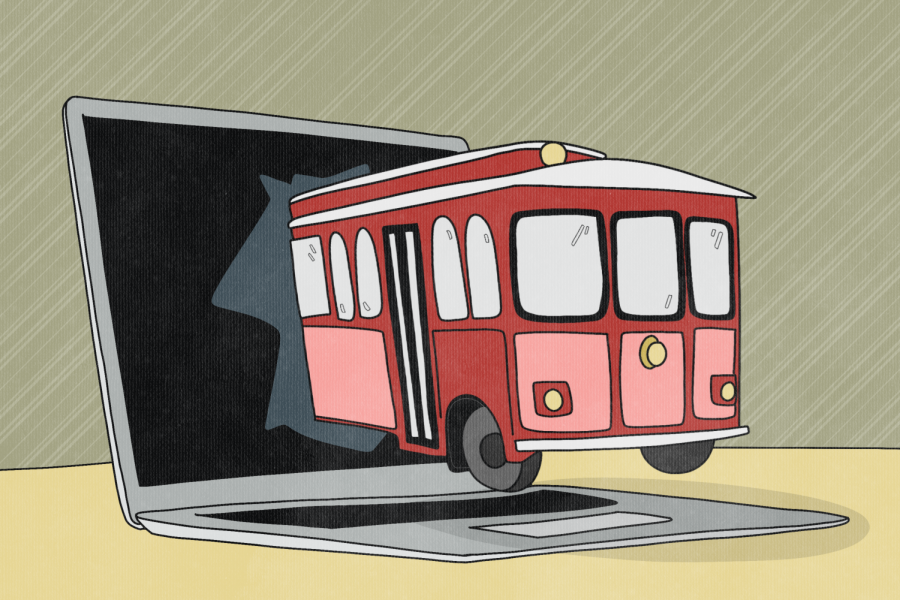Local museums increase virtual presence, connect with communities as doors reopen
Winnetka Historical Society curator Meagan McChesney said the museum is working on a traveling trunk program that brings artifacts to school classrooms and a virtual trolley tour of Winnetka historical sites.
May 27, 2021
When Rachel Ramirez goes to work as a curator at the Wilmette Historical Museum, she sits alone in her office taking calls and sending emails. She’s excited to be back with her co-workers — ever since the museum opened its doors up for visitors in April, they’ve been working in staggered shifts.
“You kind of walk around by yourself, and it’s echoing and empty,” Ramirez said.
Because the museum is currently open by appointment only, Ramirez said it’s been harder to connect with community members, which is her favorite part of her job. The museum gets most of its artifacts from resident donations, and Ramirez said she loved talking to people who walk in, hearing their stories and seeing photos from their ancestors.
Currently, Ramirez interacts with visitors either by phone or when they make appointments to visit the museum. But the appointment model doesn’t feel the same as before.
“We were just open and you never knew who’s gonna walk through the door,” Ramirez said. “I feel like now that we’re open by appointment, it’s a completely different mindset. You know who’s coming and it’s like nothing is really a surprise anymore.”
As more local museums begin opening their doors to appointments from visitors, some curators have reflected on increased museum social media presence and the digitization of collections — initiatives started in response to the COVID-19 pandemic that have proven to be invaluable for connecting museums with community members.
Meagan McChesney, a curator at the Winnetka Historical Society, said the museum’s goal for the next year is to bring history to the community instead of having residents come to the museum.
Most of all, she doesn’t want to gatekeep the museum’s information.
“I use the term gatekeeper,” McChesney said, “because as a researcher and as a historian, I’ve been in situations where I’ve tried to access information, and I have not been able to access it.”
In an effort to increase community access to museum information, the Winnetka Historical Society has digitized some of their collections, McChesney said. Residents can also call the museum to learn about the history of their homes, including its designers and past residents. The museum has also started working on a traveling trunk program that brings artifacts to school classrooms and a virtual trolley tour of Winnetka historical sites.
According to McChesney, the Winnetka Historical Society’s social media manager has transformed the museum’s social media accounts by connecting artifacts with the present to drive up engagement.
For Ramirez, social media has offered a new opportunity to present information in a less scholarly way. She said there’s a stereotype of history museums and curators being guarded and having a “get your hands off” attitude, but social media allows for a more casual way of communicating and building relationships with the community.
“We want people to be comfortable to come to see us, or to call us or to email us,” Ramirez said. “We’re open to people seeing our fun side.”
Joseph Gackstetter, collections manager at the Mitchell Museum of the American Indian, said the museum has been able to develop partnerships with organizations nationwide during the pandemic.
Through these collaborations, the Mitchell has hosted virtual events that have had a wider reach and further the museum’s mission to promote a deeper understanding of American Indian and First Nation art, history and culture.
Recently, the museum worked with the Northlight Theatre in Skokie to put on a performance of “Sliver of a Full Moon,” a play that highlights legislation addressing violent crimes committed by non-Indian abusers on tribal lands.
Gackstetter said it was particularly illuminating to see how the play traced past issues into the present, and is excited for future collaborations that will continue to engage history in contemporary discussions.
“I’m hoping we can continue the momentum that we have in being able to grow our collaborations and programming in general and diversify what it is that we’re able to bring to our members and to our audience,” Gackstetter said.
Email: [email protected]
Twitter: @yimingfuu
Related Stories:
— Museums face uncertainty as COVID-19 cases rise nationwide
— Chicagoland museums reopen during COVID-19
— The Block Museum exhibition explores self-care and community


